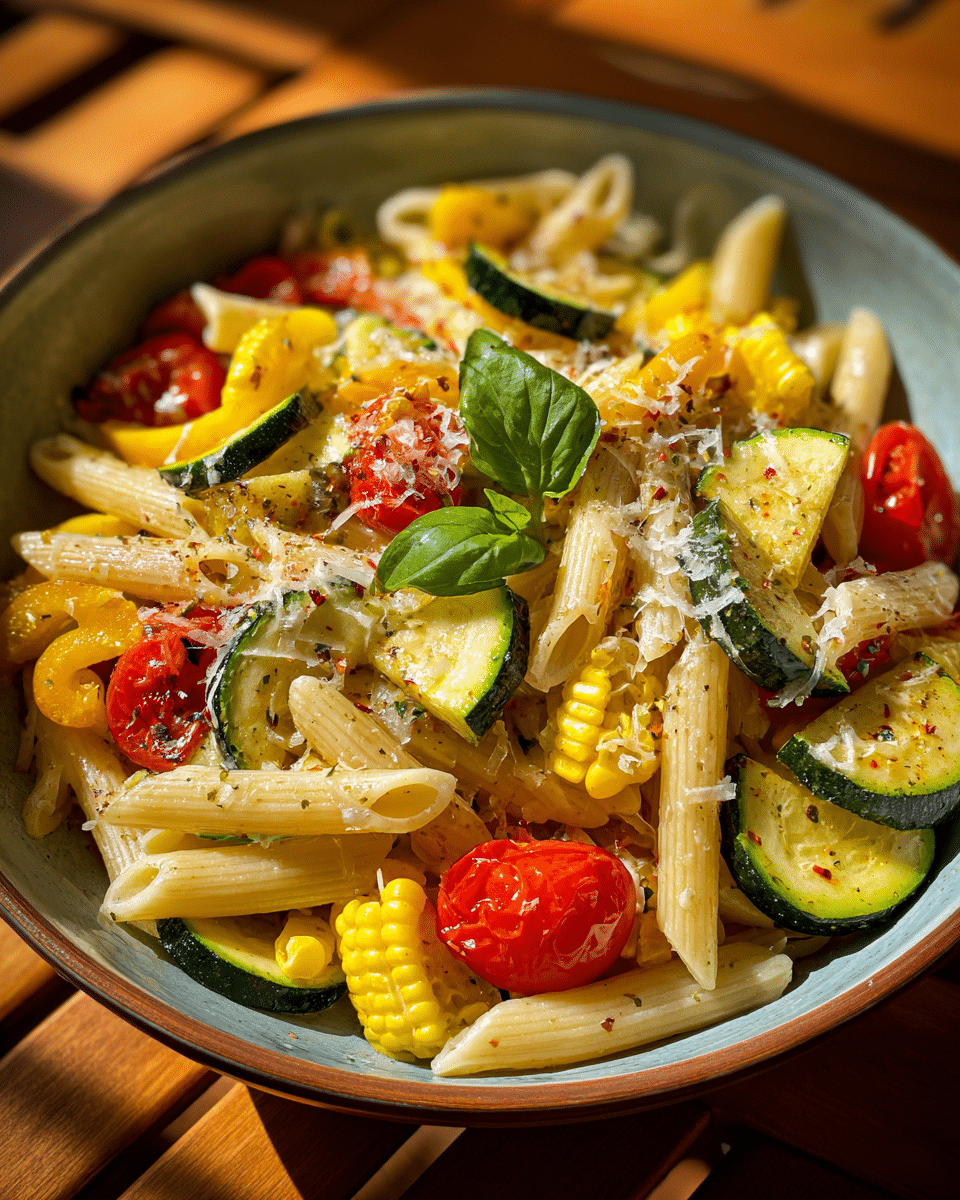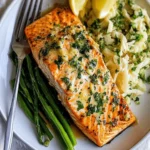Summer Veggie Pasta is a vibrant and refreshing dish that captures the best of the season’s produce. With colorful vegetables like cherry tomatoes, zucchini, and bell peppers tossed in a light garlic and olive oil sauce, this pasta is perfect for a quick weeknight meal or a casual gathering. It’s not only beautiful on the plate but also full of nutrients and bright flavors, making it a wholesome vegetarian option that doesn’t compromise on taste.
FULL RECIPE
Ingredients
- 12 oz pasta (penne, fusilli, or spaghetti)
- 2 tablespoons olive oil
- 3 cloves garlic, minced
- 1 medium zucchini, sliced into half-moons
- 1 yellow squash, sliced into half-moons
- 1 red bell pepper, thinly sliced
- 1 cup cherry tomatoes, halved
- 1 cup corn kernels (fresh or frozen)
- 1 teaspoon salt
- ½ teaspoon black pepper
- ½ teaspoon red pepper flakes (optional)
- ½ cup grated Parmesan cheese (optional)
- ¼ cup fresh basil leaves, chopped
- Juice of ½ lemon
Directions
- Bring a large pot of salted water to a boil. Cook the pasta according to package instructions until al dente. Drain and set aside.
- While the pasta is cooking, heat olive oil in a large skillet over medium heat. Add the minced garlic and sauté for about 30 seconds until fragrant.
- Add zucchini, yellow squash, and red bell pepper to the skillet. Cook for 4–5 minutes, stirring occasionally, until just tender.
- Stir in cherry tomatoes and corn. Cook for another 2–3 minutes until the tomatoes begin to soften.
- Season the vegetables with salt, black pepper, and red pepper flakes if using.
- Add the cooked pasta to the skillet and toss to combine with the vegetables.
- Stir in lemon juice, fresh basil, and Parmesan cheese if using. Toss everything until well mixed and heated through.
- Serve warm, garnished with extra basil or cheese if desired.
Nutrition Facts
- Calories: 420
- Total Fat: 12g
- Saturated Fat: 3g
- Cholesterol: 10mg
- Sodium: 480mg
- Total Carbohydrates: 65g
- Dietary Fiber: 6g
- Sugars: 7g
- Protein: 13g
- Vitamin A: 35% DV
- Vitamin C: 70% DV
- Calcium: 15% DV
- Iron: 20% DV
Seasonal Freshness and Flavor
Summer Veggie Pasta shines because it embraces the peak flavors of summer produce. The use of fresh zucchini, bell peppers, cherry tomatoes, and corn means every bite bursts with natural sweetness and vibrant textures. This seasonal approach ensures the pasta is light and refreshing, perfect for warm weather meals when heavy dishes feel overwhelming. Using fresh vegetables also enhances the overall nutritional profile of the dish.
Health Benefits
This pasta recipe is a powerhouse of vitamins, minerals, and antioxidants. The vegetables contribute a significant amount of dietary fiber, vitamins A and C, and essential minerals like potassium and magnesium. Olive oil adds heart-healthy monounsaturated fats, while garlic is known for its anti-inflammatory and immune-boosting properties. The dish provides a balanced combination of carbohydrates and plant-based nutrients, making it a nutritious choice for a well-rounded diet.
Versatility and Dietary Adaptations
Summer Veggie Pasta is highly adaptable to different dietary preferences. It can easily be made vegan by skipping the Parmesan cheese or substituting it with a plant-based alternative. For gluten-free options, using gluten-free pasta maintains the dish’s accessibility. Moreover, you can modify the vegetables depending on what’s available seasonally or personal preference, such as adding asparagus, spinach, or mushrooms, making it a flexible dish that can be tailored to your needs.
Cooking Techniques for Optimal Texture
The key to this recipe is cooking the vegetables just right — tender but still crisp to retain their bright colors and fresh flavors. Sautéing the vegetables in olive oil over medium heat allows them to soften slightly without becoming mushy, which preserves their texture and nutritional value. Tossing the pasta and veggies together off the heat prevents overcooking and keeps the dish light and vibrant.
Flavor Enhancements and Seasonings
Garlic and fresh basil are fundamental in elevating the flavor profile of Summer Veggie Pasta. The garlic infuses the olive oil with a warm, aromatic base, while fresh basil adds a sweet, peppery note that complements the vegetables. The addition of lemon juice provides a bright acidity that balances the richness of the olive oil and cheese. Optional red pepper flakes can introduce a subtle heat, enhancing the complexity of the dish without overpowering the fresh produce.
Serving Suggestions and Pairings
This pasta works well as a standalone meal or alongside a variety of dishes. It pairs beautifully with grilled chicken, fish, or tofu for added protein. For a lighter accompaniment, a crisp green salad or crusty whole-grain bread works perfectly. A chilled white wine or sparkling water with lemon makes a refreshing beverage choice that complements the fresh, summery flavors.
Storage and Leftover Tips
Summer Veggie Pasta can be stored in an airtight container in the refrigerator for up to 3 days. Because the vegetables may release water over time, it’s best to keep any cheese or fresh herbs separate and add them fresh before serving leftovers. Reheat gently on the stovetop or microwave to avoid sogginess. This pasta can also be enjoyed cold as a pasta salad, making it versatile for picnics or packed lunches.
Nutritional Considerations
This recipe offers a good balance of macronutrients with moderate calories, making it suitable for weight management. The fiber content supports digestive health and provides a feeling of fullness. While the dish is relatively low in protein, pairing it with a protein source can help round out the meal for more sustained energy. The use of olive oil supports cardiovascular health, while the abundance of vegetables ensures a high intake of antioxidants and phytochemicals.
Variations to Try
Experimenting with Summer Veggie Pasta can lead to delightful new versions. Try adding fresh herbs like parsley or oregano for different herbal notes. Incorporate nuts such as toasted pine nuts or slivered almonds for crunch. Swap the vegetables for roasted eggplant or artichoke hearts to give the dish a Mediterranean twist. Using whole wheat or legume-based pasta can boost fiber and protein content, offering a heartier option.
Cultural Influences and Inspiration
This pasta draws inspiration from Mediterranean cuisine, known for its emphasis on fresh vegetables, olive oil, and simple yet flavorful preparations. The use of fresh herbs and lemon is typical of this region’s cooking style, which values balance and wholesome ingredients. The dish reflects a modern take on traditional summer pasta recipes, combining convenience with nutritious, seasonal ingredients.
Tips for Perfect Pasta Cooking
Cooking pasta al dente is crucial for this recipe, as it ensures the pasta holds up well when mixed with the sautéed vegetables. Overcooked pasta can become mushy and dilute the fresh flavors. Salting the boiling water adequately enhances the pasta’s taste and helps season the dish evenly. Saving a bit of pasta water before draining can be useful for loosening the sauce if the mixture seems dry.
Conclusion
Summer Veggie Pasta is a delightful celebration of seasonal produce that offers a perfect balance of nutrition, flavor, and ease. Its vibrant colors and fresh taste make it an appealing choice for warm days when lighter meals are preferred. The recipe’s versatility, health benefits, and straightforward preparation make it an excellent addition to any home cook’s repertoire, offering endless opportunities for customization and enjoyment throughout the summer months.






